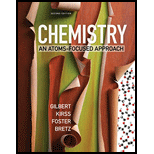
To determine:
a) Oxidation numbers of all the elements in the given reaction.
b) The elements being oxidized and being reduced.
Answer to Problem 8.89QA
Solution:
a)
| Elements | O.N. on reactant side | O.N. on product side |
| Si | +4 | +4 |
| O | -2 | -2 (in |
| Fe | +3 (two Fe) and +2 (one Fe) | +2 |
In this reaction, iron is reduced
b)
| Elements | O.N. on reactant side | O.N. on product side |
| Si | +4 | +4 |
| O | -2 (in |
-2 |
| Fe | 0 | +2 |
In this reaction, iron is oxidized
c)
| Elements | O.N. on reactant side | O.N. on product side |
| H | +1 | +1 |
| O | -2 (in |
-2 |
| Fe | +2 | +3 |
In this reaction, iron is oxidized
Explanation of Solution
1) Concept:
We are asked to assign oxidation numbers to each element in the given reactions. We will follow the rules for assigning oxidation numbers to atoms. Using the changes in oxidation number, we can find out oxidized and reduced elements in the reactions. Oxidation numbers of some elements are constant as, in case of O, the common oxidation number is -2 with some exceptions. Also, the oxidation number of H is +1 except when it is attached to metal (-1).
2) Given:
i)
ii)
iii)
3) Calculations:
a)
The sum of oxidation numbers of neutral compounds equals zero. Therefore, in
Let the oxidation number of
The oxidation state of
So, in
Oxidation state of
Here, two
Here, in the reaction, as
b)
The sum of oxidation number of neutral compounds equals zero. So, in
Let the oxidation number of
Oxidation number of compounds in its elemental form is zero. So oxidation state of
Oxidation state in
So here, two
Here, in the reaction, as
c)
The sum of oxidation number of neutral compounds equals zero. So, in
Let the oxidation number of
Oxidation number of compounds in its elemental form is zero. So oxidation state of
So, oxidation state of
So, in the reaction,
Conclusion:
Oxidation means loss of electrons, and reduction is gain of electrons. From the change in the oxidation state of elements, the oxidized and reduced species have been calculated.
Want to see more full solutions like this?
Chapter 8 Solutions
Chemistry: An Atoms-Focused Approach (Second Edition)
- Hi, I need your help with the drawing, please. I have attached the question along with my lab instructions. Please use the reaction from the lab only, as we are not allowed to use outside sources. Thank you!arrow_forwardHi, I need your help i dont know which one to draw please. I’ve attached the question along with my lab instructions. Please use the reaction from the lab only, as we are not allowed to use outside sources. Thank you!arrow_forward5. Write the formation reaction of the following complex compounds from the following reactants: 6. AgNO₃ + K₂CrO₂ + NH₄OH → 7. HgNO₃ + excess KI → 8. Al(NO₃)₃ + excess NaOH →arrow_forward
- Indicate whether the product formed in the reaction exhibits tautomerism. If so, draw the structure of the tautomers. CO₂C2H5 + CH3-NH-NH,arrow_forwardDraw the major product of this reaction N-(cyclohex-1-en-1-yl)-1-(pyrrolidino) reacts with CH2=CHCHO, heat, H3O+arrow_forwardDraw the starting material that would be needed to make this product through an intramolecular Dieckmann reactionarrow_forward
- Draw the major product of this reaction. Nitropropane reacts + pent-3-en-2-one reacts with NaOCH2CH3, CH3CHOHarrow_forwardIndicate whether the product formed in the reaction exhibits tautomerism. If so, draw the structure of the tautomers. OC2H5 + CoHs-NH-NH,arrow_forwardExplain how substitutions at the 5-position of barbituric acid increase the compound's lipophilicity.arrow_forward
- Explain how substitutions at the 5-position of phenobarbital increase the compound's lipophilicity.arrow_forwardName an interesting derivative of barbituric acid, describing its structure.arrow_forwardBriefly describe the synthesis mechanism of barbituric acid from the condensation of urea with a β-diketone.arrow_forward
 ChemistryChemistryISBN:9781305957404Author:Steven S. Zumdahl, Susan A. Zumdahl, Donald J. DeCostePublisher:Cengage Learning
ChemistryChemistryISBN:9781305957404Author:Steven S. Zumdahl, Susan A. Zumdahl, Donald J. DeCostePublisher:Cengage Learning ChemistryChemistryISBN:9781259911156Author:Raymond Chang Dr., Jason Overby ProfessorPublisher:McGraw-Hill Education
ChemistryChemistryISBN:9781259911156Author:Raymond Chang Dr., Jason Overby ProfessorPublisher:McGraw-Hill Education Principles of Instrumental AnalysisChemistryISBN:9781305577213Author:Douglas A. Skoog, F. James Holler, Stanley R. CrouchPublisher:Cengage Learning
Principles of Instrumental AnalysisChemistryISBN:9781305577213Author:Douglas A. Skoog, F. James Holler, Stanley R. CrouchPublisher:Cengage Learning Organic ChemistryChemistryISBN:9780078021558Author:Janice Gorzynski Smith Dr.Publisher:McGraw-Hill Education
Organic ChemistryChemistryISBN:9780078021558Author:Janice Gorzynski Smith Dr.Publisher:McGraw-Hill Education Chemistry: Principles and ReactionsChemistryISBN:9781305079373Author:William L. Masterton, Cecile N. HurleyPublisher:Cengage Learning
Chemistry: Principles and ReactionsChemistryISBN:9781305079373Author:William L. Masterton, Cecile N. HurleyPublisher:Cengage Learning Elementary Principles of Chemical Processes, Bind...ChemistryISBN:9781118431221Author:Richard M. Felder, Ronald W. Rousseau, Lisa G. BullardPublisher:WILEY
Elementary Principles of Chemical Processes, Bind...ChemistryISBN:9781118431221Author:Richard M. Felder, Ronald W. Rousseau, Lisa G. BullardPublisher:WILEY





